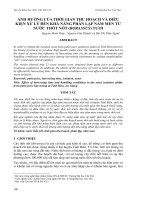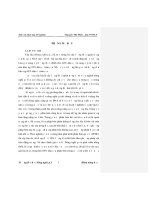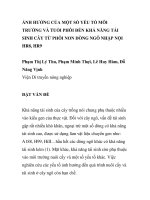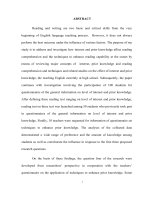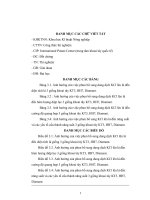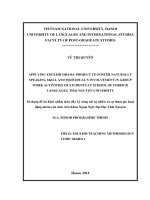ẢNH HƯỞNG CỦA LỜI DẪN TƯỜNG MINH CHO CÁC CHIẾN LƯỢC ĐỌC ĐẾN KỸ NĂNG ĐỌC HIỂU TẠI KHOA NGOẠI NGỮ, ĐẠI HỌC THÁI NGUYÊN
Bạn đang xem bản rút gọn của tài liệu. Xem và tải ngay bản đầy đủ của tài liệu tại đây (628.79 KB, 6 trang )
<span class='text_page_counter'>(1)</span><div class='page_container' data-page=1>
<b>THE EFFECTS OF EXPLICIT INSTRUCTIONS OF READING STRATEGIES </b>
<b>ON READING COMPREHENSION AT SCHOOL OF FOREIGN LANGUAGES, </b>
<b>THAI NGUYEN UNIVERSITY </b>
<b>Diem Thi Thu Thuy</b>
<i>TNU School of Foreign Languages </i>
ABSTRACT
This paper studies effects of explicit instructions of reading strategies on reading comprehension at
School of Foreign Languages, Thainguyen University and the attitude of students toward this
technique in reading classes. To achieve desired aims of the current study, the researcher
combined both qualitative and quantitative methods, including pre-test, post-test, and
questionnaire. After 10 weeks of implementing the treatment, the results of reading comprehension
tests and the questionnaire showed that explicit instructions of reading strategies helps the students
to increase their reading comprehension. The results also showed that explicit instructions helped
students to have more confident towards learning reading skills.
<i><b>Keywords: reading; explicit instructions; students; reading comprehension; skills. </b></i>
<i><b>Received: 10/01/2019; Revised: 18/3/2019; Approved: 07/5/2019 </b></i>
<b>ẢNH HƯỞNG CỦA LỜI DẪN TƯỜNG MINH CHO CÁC CHIẾN LƯỢC ĐỌC </b>
<b>ĐẾN KỸ NĂNG ĐỌC HIỂU TẠI KHOA NGOẠI NGỮ, </b>
<b>ĐẠI HỌC THÁI NGUYÊN </b>
<b>Diêm Thị Thu Thủy</b>
<i>Khoa Ngoại ngữ - ĐH Thái Nguyên </i>
TÓM TẮT
Bài viết nghiên cứu về ảnh hưởng của lời dẫn tường minh cho các chiến lược đọc hiểu đến kỹ năng
đọc hiểu tại Khoa Ngoại ngữ, Đại học Thái Nguyên và thái độ của sinh viên đối với kỹ thuật này
trong tiết học đọc. Để đạt đựơc mục tiêu nghiên cứu, tác giả đã sử dụng phương pháp phân tích
định tính và định lượng, với các cơng cụ: bài kiểm tra trước và sau, và bảng câu hỏi khảo sát. Sau
10 tuần tiến hành thử nghiệm, kết quả của các bài kiểm tra đọc hiểu và bảng hỏi đã thể hiện rằng
lời dẫn tường minh về các chiến lược đọc hiểu giúp sinh viên tăng cường kỹ năng đọc hiểu. Kết
quả còn cho thấy lời dẫn tường minh đồng thời giúp sinh viên dường như tự tin hơn với việc học
kỹ năng đọc.
<i><b>Từ khoá: kỹ năng đọc; lời dẫn tường minh; sinh viên; đọc hiểu; kỹ năng. </b></i>
<i><b>Ngày nhận bài: 10/01/2019; Ngày hoàn thiện: 18/3/2019; Ngày duyệt đăng: 07/5/2019 </b></i>
Email:
</div>
<span class='text_page_counter'>(2)</span><div class='page_container' data-page=2>
<b>1. Introduction </b>
Reading is a powerful tool for academic
success because it provides students with
access to information and is regularly
depicted as an essential element to the
academic success of EFL (English as a
Foreign Language) learners. Therefore, it
should be given an important position in
school and society if development is to be
achieved and sustained. Furthermore, the role
of teachers should be teaching guides who
give clear and strategic instructions to
students to enable them not only to deal with
tasks in class but also to work independently
with various tasks.
Researchers have long documented the
prominent role in which reading strategies
perform in assisting reading comprehension
[1], [2], [3], [4], [5]. Some of these research
also asserted that second language reading
comprehension was not simple for numerous
language learners; therefore, the majority of
learners required more time to improve their
reading comprehension performance in the
target language. As a result, the lack of
explicit instruction of reading strategies may
lead L2 (second language) readers to have
difficulty in improving their reading
comprehension.
From my own experience as a lecturer at SFL
(School of Foreign Languages) and my
observation of other English lecturers‟
lessons, I realized that the majority of the
students seem to struggle with reading when
spending most of the time looking up new
words in dictionary, showing not much
positive attitude in reading lessons. It is
surprising to note that the feedback and
comments indicating what and how to correct
their mistakes seem not work as some
students still repeat the same mistakes in their
corrections or subsequent work. This is
mainly due to the fact that they do not
understand the comments. In addition, some
students fail a test or an examination not
because they do not study, but because they
do not use effective methods or strategies to
learn. Based on the problem, the aim of this
study is to examine the effects of explicit
instructions of reading comprehension
strategies on second year non English major
students at School of Foreign Languages,
Thai Nguyen University.
<b>2. Literature review </b>
<i><b>2.1. Reading comprehension strategies </b></i>
<i>Cognitive strategies (CSs) </i>
According to BBC, cognitive strategies are
one type of learning strategies used to learn
more successfully, which include repetition,
organising new language, summarising
meaning, guessing meaning from context,
using imagery for memorisation. A cognitive
strategy could be to underline some sections
of a text, reread portions of or an entire text to
increase understanding, or reduce reading
speed when comprehension is threatened.
<i>Meta-cognitive strategies (MSs) </i>
</div>
<span class='text_page_counter'>(3)</span><div class='page_container' data-page=3>
setting or selective attention,
self-management, and goal prioritization.
As a result, I conceived meta-cognitive
reading strategies as skimming (identifying
min ideas for specific), making notes and
making inferences in this paper.
<i><b>2.2. Selected reading strategies </b></i>
The core strategies used in this paper, namely,
skimming, scanning, making inferences,
guessing new words from context.
<i>Skimming vs. scanning </i>
Skimming requires greater fluency and more
practice [8]. It is used as reading a text or a
passage quickly to get a general idea. Learners
do not need to read every word when
skimming, so teachers set this as a timed task
and to encourage speed. Scanning is to cover a
great deal of material rapidly to locate a
specific facet or piece of information. It is
useful to find specific name, date, statistic, or
fact without reading the whole text.
<i>Making inferences </i>
Inference is considered as “information that is
activated during reading yet not explicitly
stated in the text” [9, p. 556]. Since it is a
metacognitive strategy, it involves readers‟
prior knowledge from prior learning and
readers‟ personal experiences. Fortunately,
many scholars proved that young children and
beginning readers may benefit from strategies
that enhance inferences.
<i>Guessing new words from context </i>
Guessing from context refers to the ability to
infer the meaning of an expression using
contextual clues. This strategy is a key
vocabulary learning skill for dealing with
low-frequency vocabulary, particularly
in reading authentic texts [10, p.290].
<i><b>2.3. Explicit strategy instruction </b></i>
Crucial to this study is the term „explicit
strategy instruction‟. Archer and Hughes [11,
p.1] define explicit instruction as a
“systematic, direct, engaging, and success
oriented method of teaching which has been
shown to enhance students learning. It is an
instructional practice that builds interactions
between students and their teachers. Teachers
clearly state a teaching objective and follow a
definite instructional sequence.
<b>3. Research design </b>
<i><b>3.1. Participants </b></i>
The research was conducted on the non-
major English second year students at SFL.
The participants of this research are 25
second year students aged from 19 to 21 who
studied their second term of English with the
course book titled “English Written
Proficiency Intermediate 2”.
Being aware of the difficulties to implement
the treatment outside of their school timetable,
thus, the participants was taught by the
researcher through 10 weeks of the first term.
During the period of time, the students
received the eight reading strategies:
Activating background knowledge, skimming,
scanning, guessing new words, making notes,
making predictions, making inferences and
predicting what happen next through the
teacher‟s explicit direct instruction.
<i><b>3.2. Data collection instrument </b></i>
<i>Questionnaire </i>
</div>
<span class='text_page_counter'>(4)</span><div class='page_container' data-page=4>
questionnaire was administered to the subject
to gather data regarding students‟ using these
reading strategies.
<i>Pre-test and post-test </i>
In this study, I used two reading tests before
and after the treatment. Because the students
studied English at intermediate level in this
term according to the curriculum, the two
tests were designed at this level. To obtain the
reliability and validity of the tests, I adopted
tests from the question bank of English
Department of the University and piloted tests
had been applied with a group of 10 students
of a different class to make sure the difficulty
and discrimination at the right percentage.
The two tests (pre-test and post-test) were
designed with the same level: intermediate.
Each test includes five reading texts with 25
multiple choice questions in total to check if
there is any progress that the students have
made during the 10 weeks. The tests focused
on checking the students‟ reading
performance through the questions related to
only four reading strategies namely
skimming, scanning, guessing new words,
and making inferences. .
<i><b>3.3. Data collection procedure </b></i>
Before the instruments were administered,
the students had been informed about the
purpose of the study. This is in line with
research ethical principles [12], to ensure
that 25 students‟ rights are not infringed. I
personally administered the instruments to
the students during the class to establish a
rapport with the respondents and give
clarifications on unclear items.
<b>4. Results and discussion </b>
<i><b>4.1. Student’s reading comprehension </b></i>
<i>The reading performance of the students in </i>
<i>the pre-test and post-test </i>
As it can be seen from the statistics, there is a
light increase in the students‟ reading
comprehension performance. Specifically, the
average score they gained from the two tests
rises from 6.0 to 6.5 out of 10. The change is
seen not only at the average score but also at
the sub-groups of score. According to the
results, the students in the class were divided
into 5 groups: Excellent (8.5-10), Good
(7-8.4), Fair to good (5.5-6.9), Fair (4.0-5.4),
Very poor and inadequate (1-4), which based
on marking scheme at university in national
policy. Specifically, while the number of
students with good scores seems to be
unchanged, there were more students with
fair to good score (16 compared to 12) and
much less students with fair scores (4
compared to 8).
<i><b>Figure 1. The reading performance of the students </b></i>
<i><b>in the pre - test and post -test (per test) </b></i>
The results from the pre-test and post-test
demonstrated an improvement in the quality
of the participant‟s reading comprehension. It
is possibly indicated that EIRS improved the
student‟s reading performance considerably.
<i>Students’ performance at the questions </i>
<i>related to four strategies: Guessing new </i>
<i>words from context, scanning, skimming, and </i>
<i>making inferences. </i>
<i><b>4.2. Students’ performance in the pre-test </b></i>
Figure 2 and 3 present the students‟ reading
comprehension performance at the questions
related to the four strategies achieved in the
pretest, before the treatment.
</div>
<span class='text_page_counter'>(5)</span><div class='page_container' data-page=5>
of the two cognitive strategies are above 60%
while that of skimming and making
inferences are around 50%. While scanning
gains the highest percentage with 69% at the
pre-test, making inferences accounts for the
lowest percentage with only 51%. This could
be drawn that the students were better at
questions related to cognitive strategies than
that of meta-cognitive ones.
<i><b>Figure 2. Students’ performance at questions </b></i>
<i><b>related to meta-cognitive strategies in pre-test (%) </b></i>
<i><b>Figure 3. Students’ performance at questions </b></i>
<i>related to cognitive strategies in pre-test (%)</i>
<i><b>4.3. Students’ performance in the post-test </b></i>
<i><b>compared to the pre-test </b></i>
It can be said that there is much difference in
the results the students got with the questions
of meta-cognitive and cognitive strategies,
which can be seen much clearer from figure 4
and 5.
This might be blamed for the complexity of
the two kinds of questions. In addition, the
signs helping students identify the main ideas
such as sub-headings or pictures are limited in
the tests, which is dissimilar to the reading
texts extracted from newspapers and
magazines with a lot of colorful pictures they
study in the text. To conclude, making
inferences or reading between the lines is
really a challenging strategy which requires a
lot of mental practice and flexibility to think
appropriately with diverse genre of reading
texts. It can be said that, being aware of using
the a few appropriate strategies at the same
time, the students might understand the text
better, which enables them to go in the right
track as reading and avoid getting lost in the
text. Therefore, with the more confidence in
their thinking, they might determine where to
get the information for the questions.
45
50
55
60
Skimming Making
inferences
Pre-test
Post-test
<i><b>Firgure 4. Comparison of students’ performance </b></i>
<i>at questions related to meta-cognitive strategies (%) </i>
<i><b>Figure 5. Comparison of students’ performance at </b></i>
<i><b>questions related to cognitive strategies (%) </b></i>
<b>5. Dicussions </b>
</div>
<span class='text_page_counter'>(6)</span><div class='page_container' data-page=6>
revealed that there was a little improvement
in reading comprehension. The reason might
be that the clear instructions of how to apply
these strategies and reading activities
provided in the course was useful because it
provides students not only the proper ways to
deal with the questions from the texts in their
course but also the suitable tactics to answer
questions in the different texts of the post- test
when the teacher was not there to assist them.
In addition, the immediate practice with
specific texts after the teacher „guidance
enabled them to clarify the strategies and then
easily remember and apply them next time.
As a result, when the students understood
thoroughly and fully, they wanted to use them
with enjoyment, therefore, they can acquire
the knowledge through reading texts.
<b>6. Conclusion </b>
In summary, on the basis of the results of the
current study, the researcher comes to the
conclusion that, explicit instruction of reading
strategies has positive effects on the students‟
reading comprehension. In addition, the
students also highly appreciate the effects of
teaching reading strategies explicitly because
of its advantages and want to continue using
the strategies in the future. It is recommended
that the implementation of the program
should be added in the curriculum with the
approval of school‟s board because explicit
instruction of reading strategies benefits
students‟ improvement in language
development.
REFERENCES
<i>[1]. Lencioni, G.M., The Effects of Explicit </i>
<i>Reading Strategy Instruction and Cooperative </i>
<i>Learning on Reading Comprehension in </i>
<i>Fourth Grade Students, 2013, Retrieved from </i>
/>i?article=1069&context=diss.
<i>[2]. Yazdani, M.M. “The Explicit Instruction of </i>
Reading Strategies: Directed Reading
Thinking Activity vs. Guided Reading
<i>Strategies”, International Journal of Applied </i>
<i>Linguistics & English Literature, Vol. 4 No. </i>
3, pp. 53-60; May 2015
<i>[3]. Atkins, J.G., The Effect of Explicit Teaching </i>
<i>of Comprehension Strategies on Reading </i>
<i>Comprehension in Elementary School, 2013. </i>
Retrieved from http://academiccommons.
columbia.edu/catalog/ac%3A161700.
<i>[4]. Hoang, K.L., An Investigation Into Cognitive </i>
<i>And Meta-Cognitive Strategies Used In </i>
<i>Academic Reading Comprehension By </i>
<i>First-Year English Majors And The Correlation </i>
<i>Between Strategy Utilization And Students’ </i>
<i>Proficiency, Hanoi University, 2014. </i>
<i>[5]. Nguyen, T.H., The Effects Of Reciprocal </i>
<i>Teaching On The Second Year Students' </i>
<i>English Reading Comprehension At The </i>
<i>University Of Labor And Social Affairs, </i>
Hanoi University, 2012.
[6]. Sheorey, R., & Mokhtari, K. “Differences in
the metacognitive awareness of reading
strategies among native and non-native
<i>readers”, System , 29 (4), 431- 449, 2001. </i>
[7]. Phakiti, A., “A closer look at the relationship
of cognitive and metacognitive strategy use to
EFL reading achievement test performance”,
<i>Language Testing, 20 (1), 26-56, 2003. </i>
[8]. Mahmoud, SHBA. & Muwafaq, SB., “The
Effect ofSpeed Reading Strategies on
Developing Reading Comprehension among
the 2nd Secondary Students in English
<i>Language”, English Language Teaching, Vol. </i>
7, No. 6. Canadian Center of Science and
Education, 2014.
[9]. Van den Broek, P., “Comprehension and
memory of narrative texts: Inference and
<i>coherence”, Handbook of psycholinguistics. </i>
Edited by M.A. Gernsbacher. San Diego:
Academic Press, 1994.
<i>[10]. Clece-Murica, M., Teaching English as a </i>
<i>second or foreign language (3rd .ed.). U.S.A: </i>
Heinle &Heinle, Inc., 2001.
<i>[11]. Archer A. L., Hughes C. A., Explicit </i>
<i>instruction: Effective and efficient teaching. </i>
New York, NY: Guilford Press, 2011.
</div>
<!--links-->
Nghiên cứu ảnh hưởng của mật độ và một số công thức phân bón đến khả năng sinh trưởng,phát triển của cây dứa sợi(agave sisalana perrine) tại huyện ninh sơn tỉnh ninh thuận
- 128
- 887
- 0
